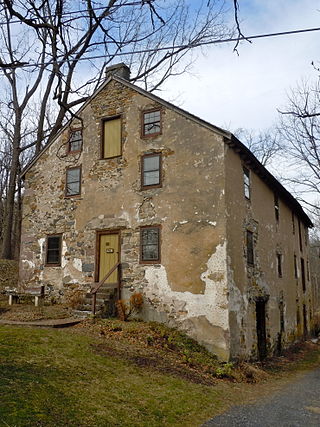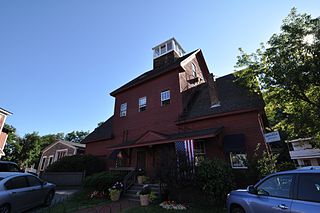
East Brunswick Township is a township in Schuylkill County, Pennsylvania. Brunswick Township was formed in 1801 as one of the original townships of Schuylkill County, being named for Brunswick (Braunschweig), Germany. In 1834, Brunswick Township was divided into East and West Brunswick Townships. Today both townships are served by the Blue Mountain School District.

Mill Creek is a neighborhood in the West Philadelphia section of Philadelphia, Pennsylvania, United States. It sits between 44th and 52nd Streets, north of Market Street and south of Girard Avenue. It was named for Philadelphia's Mill Creek, which was buried during 19th-century sewer system improvements. In 1961, the sewer collapsed, taking homes with it.

Fishing Creek is a 42.8-mile-long (68.9 km) tributary of Bald Eagle Creek in Clinton County, Pennsylvania, in the United States.

The Newlin Mill Complex, also referred to as The Newlin Grist Mill, is a water-powered gristmill on the west branch of Chester Creek near Concordville, Pennsylvania built in 1704 by Nathaniel and Mary Newlin and operated commercially until 1941. During its three centuries of operation, the mill has been known as the Lower Mill, the Markham Mill, the Seventeen-O-Four Mill and the Concord Flour Mill. In 1958 the mill property was bought by E. Mortimer Newlin, restored and given to the Nicholas Newlin Foundation to use as a historical park. Water power is still used to grind corn meal which is sold on site. The park includes five historical buildings, which were added to the National Register of Historic Places in 1983, and 150 acres (61 ha) of natural woodland.

The Burnt Cabins Gristmill Property is an historic house and gristmill which are located in Burnt Cabins, Pennsylvania. It is also a contributing property to the Burnt Cabins Historic District.

The Logan Mills Gristmill is a historic grist mill located at Logan Township in Clinton County, Pennsylvania. It was built in about 1840, and is a 3 1/2-story, coursed stone building with a tin-covered gable roof. It is three bays by four bays. It includes most of its original machinery. It was powered by water diverted from Fishing Creek.

Mount Joy, also known as the Peter Legaux Mansion, is an historic, American house that is located in the Spring Mill section of Whitemarsh Township, Montgomery County, Pennsylvania.

The Springfield Mill, also known as the Piper-Streeper Mill, is an historic, American gristmill that is located near the Wissahickon Creek in Erdenheim, Springfield Township, Montgomery County, Pennsylvania.

The Miller's House at Spring Mill is an historic, American building that is located in the Spring Mill section of Whitemarsh, Montgomery County, Pennsylvania, United States. Located roughly two hundred feet from where Spring Mill Creek empties into the Schuylkill River, it is situated approximately a quarter of a mile southeast of the Borough of Conshohocken.

The Metz Ice Plant, also known as the Jacob Klaer Gristmill and the Milford Ice and Refrigeration Company, is an historic, American ice manufacturing plant that is located in the Delaware Water Gap National Recreation Area in Milford, Pike County, Pennsylvania.

St. Vincent Archabbey Gristmill, also known as The Gristmill, is a historic grist mill located in Unity Township, Westmoreland County, Pennsylvania. The original section was built in 1854, and is a four-story, frame structure measuring 45 by 40 feet. A 45-by-45-foot addition was built in 1883. The mill operated by steam and remains in use. It was built as part of Saint Vincent Archabbey, the first Benedictine Monastery in the United States, which opened in 1846.

The Griesemer-Brown Mill Complex is an historic grist mill complex which is located on Monocacy Creek in Amity Township, Berks County, Pennsylvania.

The Nathan Cooper Gristmill is a historic gristmill on the Black River located at 66 NJ Route 24 in Chester Township, Morris County, New Jersey. It was added to the National Register of Historic Places on November 21, 1976 for its significance in industry.

The Spring Mill Complex, also known as the Gunkle Spring Mill, is a historic American gristmill complex constructed in 1793. The complex is located in East Whiteland Township, Chester County, Pennsylvania. It was listed on the National Register of Historic Places in 1978.

The Larkin Covered Bridge is a 60-foot-long (18 m), Burr truss wooden covered bridge that is located outside of Chester Springs, Chester County, Pennsylvania, near the village of Eagle. The bridge, which originally crossed over Marsh Creek, now spans a dry ditch and is a feature of the Upper Uwchlan Township trail system.

The John Knauer House and Mill, also known as the Knauer Mill, is an historic American grist mill complex that is located in Warwick Township, Chester County, Pennsylvania. The site is situated in the Hopewell Big Woods.

Graves Mill, also known as Jones Mill and Beech Grove Mill, is a historic grist mill complex located near Wolftown, Madison County, Virginia. The complex includes a three-story, heavy timber frame gristmill; a two-story, log, frame, and weatherboard miller's house; and a one-story heavy timber frame barn. The gristmill was built about 1798, probably on the foundation of an earlier gristmill built about 1745. It was owned and operated by members of the Thomas Graves family for more than a century.

Spring Mill is an unincorporated community in Whitemarsh Township, Montgomery County, Pennsylvania, United States.

The Ashland Gristmill and Dam are a historic former industrial facility in the heart of Ashland, New Hampshire. Built in 1903 on the site of an older mill, the gristmill demonstrates the continuing viability of wood framing for mill buildings in an era when it had become uncommon. The property was listed on the National Register of Historic Places in 1979. It has been converted to professional offices.

Taylor's Mill Historic District, a 26-acre (11 ha) historic district featuring the gristmill Taylor's Mill, is located along Taylor's Mill Road and Rockaway Road near Oldwick in Readington Township, Hunterdon County, New Jersey. It was added to the National Register of Historic Places on June 11, 1992 for its significance in architecture, exploration/settlement, industry, and military. The district boundary was increased by 8 acres (3.2 ha) in 1997 to cross the Rockaway Creek and extend into Tewksbury Township.
























